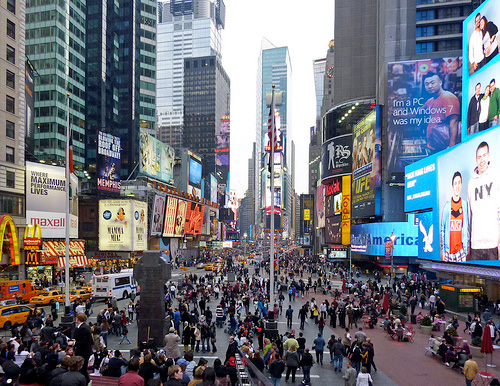Recession or depression? Estate taxes or death taxes? How events or policies are named, or “framed,” has become crucial to their viability. Indeed, the ascendancy of the right wing in the U.S. in recent decades is attributed in part to the Right’s mastery of political phraseology to demonize leftist and even centrist policies.

Framing affects the struggle over street space as well. Tabloid headlines about “kamikaze cyclists” and “two-wheeled terrorists” in the 1980s literally framed bike messengers as Public Enemy #1 and emboldened Mayor Ed Koch to try to ban bicycling in midtown. Road widenings are still customarily branded as “improvements” rather than simply identified as expansions. Most news outlets report plane crashes as crashes but call car crashes accidents.
With this in mind, let’s train a verbal lens on the New York Times’ full-page treatment yesterday of the Broadway road diet.
The article, by Times transportation reporter Michael Grynbaum, is exemplary in many respects. It thoughtfully lets transportation guru Jeff Zupan declare that the stepwise transformation of Manhattan’s central thoroughfare is boosting the status of pedestrians throughout town:
“It’s given people a different feeling about walking in the city, that the pedestrian isn’t a second-class citizen who has to always be on the lookout of getting run over.”
On the key issue of traffic flow, Grynbaum notes that Broadway's “awkward three-way intersections with other avenues created gridlock,” and he has Janette Sadik-Khan explain that “We’re making the [street] network work like it was supposed to.” To back up the DOT Commissioner's appeal to New Yorkers to embrace Broadway as a “green ribbon,” Grynbaum invokes “Gridlock” Sam Schwartz, whom he dubs “the éminence grise of the city’s traffic circles”:
“It sounds counterintuitive that removing a street can make things better. But it was a mistake in 1811 when they left Broadway in as a traffic street.”
Educational indeed… for readers who make it to the tenth paragraph. But earlier, more prominent passages may imprint a less appetizing picture on other, perhaps more typical readers:
[U]nder the Bloomberg administration, Broadway has been transformed, from a grand avenue that ferried automobiles on a scenic route through Midtown to a narrow passageway with barely more room for cars than a sleepy street in Greenwich Village. (second paragraph)
The Great White Way … has been diminished by a bicycle lane and a green-painted, traffic-free section intended for pedestrians …” (caption)
In two years, roughly three and a half miles of the street’s moving lanes have vanished … For the first time in New York’s modern era, Broadway no longer offers a continuous path from the Bronx to the Battery. (third paragraph)
And, in case anyone missed the point, the full-page diagram tracing the street from Columbus Circle to below Madison Square Park is headlined “Not So Broadway.”
The takeaway, then, is mixed. Readers who go the distance are treated to the wisdom of NYC’s leading transportation lights. But those who merely inhale the first few bits learn that Broadway has been “diminished” even though only the motorized lanes have shrunk; and that parts of the once-Great White Way have “vanished” rather than been repurposed. The “grand avenue” renowned as a “scenic route” through the heart of the city is no more -- the implication being that New York itself is being made less grand, even, gasp, “pedestrian.”
Perhaps inadvertently, the piece’s heavy reliance on talking heads may serve to reinforce another negative frame: that Sadik-Khan and other city officials are "imposing" alien ideas on New Yorkers, even though the midtown business community -- through the Times Square Alliance -- generated the initial momentum for the pedestrian reclamation of Times Square, and even though we know public opinion of the transformations is quite favorable.
The article’s true soul may reside in the lone everyman quoted, whom Grynbaum describes as “a daily car commuter from Queens who was parked on Broadway at 33rd Street the other day“:
I know they’re trying to beautify the city, but it’s killing the drivers. It’s frustrating. They don’t want you to drive into the city.
This fellow comes off as reasonable, even sweet. Yet his “daily car commute” costs other New Yorkers -- truckers, bus riders, and his fellow drivers -- a collective 3-4 hours in lost time valued at $100 or more each day. Framing the city’s ongoing traffic disaster in these terms may be crucial to maintaining Broadway as a permanent “green ribbon,” not to mention winning the rest of the livable streets agenda, from pedestrians’ rights to traffic pricing, that can make New York a city fit for working and living.





